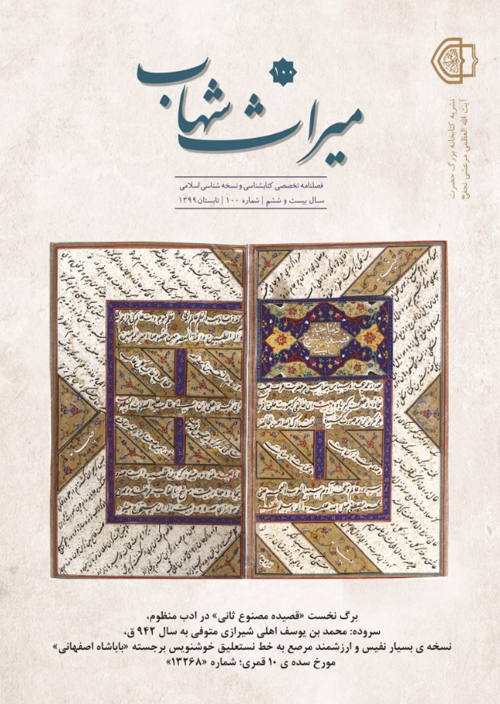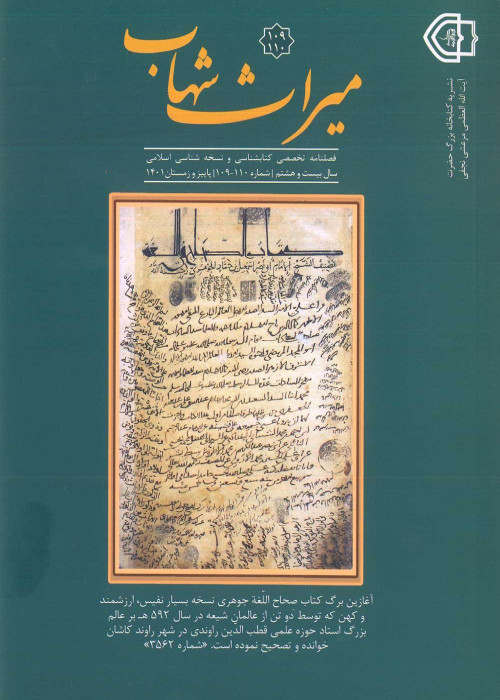فهرست مطالب

نشریه میراث شهاب
پیاپی 100 (تابستان 1399)
- تاریخ انتشار: 1400/02/28
- تعداد عناوین: 12
- مقالات
-
صفحه 3
- شرح حال نگاری
-
صفحه 117
-
صفحه 161
- تصحیح متون
-
صفحه 203
-
صفحه 233
-
صفحه 293
-
صفحه 299
-
Page 3
The article contains twenty research points that have been discussed from the perspective of bibliography, biography (Tarajem), Rijal, history, geopgraphy and other aspects based on the findings of the manuscripts and their analysis to understand ancient Bahrain and the place of Shia there. Among these points in bibliography are: significance of Bahraini scholars’ ownerships on and possessions of manuscripts in 1129 A.H., the collection of manuscript articles of 9th century written by Bahraini scholar, writing of Mohaqqiq Karaki’s treatise on invalidators of prayers (Khalal al-Salat), Ali ibn Sulayman Bahrani’s possession of Sulaim’s book, Yasin Beladi’s note on borrowing the book, introducing some of exquisite scripts found in Ale Zain al-Deen Ahsaee’s library, Ahsaee scholars’ possession of the script of Intikhab al-Jayyid Damestani (Good Choice by Damestani). There is also some points on historiography of ancient Bahrain such as Ahsaee scholars migration to Iran, Basra, and Najaf as a result of factors like Wahhabis’ invasion in 13th century and its documents and the detailed account of the conquest of Qatif in 10th century. Introducing Ahsaee families like Ale Aithan family and its well-known men such as Sheikh Hussein Sheikh Muhammad is also among the re search subjects addressed here. Geographical points of ancient Bahrain including a list of villages in the re gion based on colophons of the manuscripts, the Persian village of Awal and Mohammad ibn Hirz Bahrani in 11th century, the village of Nadid in Ahsa’ and a number of its scholars such as Sayyid Hossein ibn Ahmad Nadidi, and Qabr al-’ajam which is a tomb in Qatif region are mentioned as well.
Keywords: Shia history – ancient Bahrain, Shia families – Bahrain, Qatifand Ahsa’, Shia manuscripts – Bahraini scholars, Ahsa’, Shia scholars– migrations, ancient Bahrain – geography, manuscripts – study -
Page 63
The theme in this article is Reviewing sources of manu scripts which belong to Roman Seljuks secretariat in 7th century A.H. (available in Ayatollah Mar’ashi’s Library No.11136) and include 247 pieces of document. Most of the documents in this collection, which previously belonged to Haj Hossein Nakhjavani in Tabriz, are related to Iran and Iranians and their connections to Rome. These documents fall into two classes: state and private documents or sultaniyyat (royal) and ekhwaniyyat (brotherly or common). The exact details of the version, its theme and a biography of its donor are also included in the article. Keywords: Ayatollah Marashi’s Library – manuscript collection no.11136; Roman Seljuks – historical documents; historical documents – 7th century (A.H.); relations between Iran and Rome – 7th century A.H.; state and private deeds; Nakhjavani, Hossein – manuscripts.
-
Page 85
Here several joint catalogs of Persian manuscripts which have been written in about a century and are expressed in chronological order are introduced and criticized. There are mentioned more details about the following six books: Joint Catalog by Charles Storey (1928 A.D.); Persian Manuscripts Catalog by Ahmad Monzavi (1377 – 1353 S.H.); Persian Manuscripts of Pakistan Joint Catalog by Ahmad Mon zavi (1348 – 1377 S.H. onwards); Persian Books Index by Ahmad Mon zavi (1374 – 1395 S.H.); Joint Index of Medical and Related Sciences Manuscripts in Iran’s Libraries by Mohammad-Reza Shams Ardakani Et al. (1387 S.H.); Lists of Iran’s Manuscripts Known as FANKHA by Mostafa Derayati (1390 – 1393).
Keywords: manuscripts – cataloging, joint catalogs of manuscripts, Monzavi, Ahmad, Storey, Charles, Derayati, Mostafa, Shams Ardakani, Mohammad-Reza -
Page 103
Ja’far ibn Musa al-Kadhim (Salaam be upon them) is one the sons of the infallibles whose tomb in located in Pishva, a small city in Tehran province. Through a library method, this article studies his genealogy and tomb. He was an immediate son to Imam Musa Kadhim (Salaam be upon him) and his mother, whose name is not mentioned in the sources, was a maid. This name, Ja’far ibn Musa, along with the nickname ‘Abu al-Hasan’ and the title ‘al-Khawri’, attributed to a small village in Mecca called Khawar, is mentioned in historical and gene alogical sources. Sources from the third century onwards in which his name and tomb and those who are known as the owners of this tomb are addressed in this article
-
Page 117
This article is on a book called Ijaz of Mafatih el-I’jaz by Khajeh Mohammad Dehdar Shirazi (947 – 1016 A.H.) which is a sum mary of the book Mafatih el-I’jaz (Keys of Miracle) by Asiri Lahiji (d. 912 A.H.). Asiri has written the book as a description for Golshan-e- Raz a mystical poetry by Mahmoud Shabestari. Shabestari has com posed this poetry in 718 A.H. as a reply to the then governor Alem Hosseini Heravi about mysticism. The author give a brief biography of these figures as well as some unspoken points. Dehdar accepted Indian Shia rulers’ invitation and moved from Shiraz to India, resided there, wrote 60 books and passed away there.
Keywords: Ijaz Mafatih al-I’jaz (book) – briefing, Mafatih al-I’jaz(book) – summary, Golshan-e-Raz (The Garden of Secrecy) (poetry) –commentaries, mystical scripts, Shia scholars – 10th-11th centuries A.H., Shia scholars – India -
Page 161
This article introduces about Mohammad-Mohsen ‘Asi Es fahani Rashti (13th Century A.H.), a man of books with a lot of works and a son to Mohammad-Rafi’a Gilani (d. 1268 A.H.), who wrote 180 books in 700 volumes among which scripts of 100 titles in 250 volumes are accessible. Biographies of him, his father, brothers, children, mas ters, contemporaries, life chronicle and its analysis, examples of prose and poetry, and thematic bibliography of his works are addressed here.
Keywords: ‘Asi Esfahani Rashti, Mohammad-Mohsen (13th centuryA.H.), Gilani, Mohammad-Rafi’a, Shia scholars – 13th century, Shiascholars – Gilan, Shia scholars – Esfahan, Shia scholars bibliography -
Page 193
The article introduces three masters of As’ad ibn Shafrouh Esfahani (a 6th and 7th century Shia scholar). They are Zahir al-Din Abu al-Qasem Jasti, Abu Esmael Sokkari Esfahani, and Shahab ul-Din Ban dar Qommi. This point is based on a 12th century manuscript from Aya tollah Marashi Library. These figures’ biography, precise description of this version, and proofs of the author’s claim are presented in details.
Keywords: Ibn Shafrouh Esfahani, As’ad, Jasti, Zahir al-Din Abual-Qasem, Sokkari Esfahani, Abu Esmael, Bandar Qommi, Shahab ul-Din, Shia scholars – 6th, 7th centuries A.H., manuscripts – AyatollahMarashi Library -
Page 203
This article describes an unpublished work of Sayyid Mo hammad-Mahdi Qazwini Qawam al-Din Saifi (12th century A.H.) in which he has brought the script of the book Tahzib al-Akhlaq (Refine ment of Character), by Abd al-Rahman Iji on practical wisdom and pu rification of moralities, and make it into a poem with 200 verses. This poetry will be published for the first time and based on three manu scripts. The author’s biography is also included in the article.
Keywords: Tahzib al-Akhlaq (Refinement of Character) (book) – poetry, Tahzib al-Akhlaq as poem (book), practical wisdom, Saifi Qazwini, Qawam al-Din – biography, Iji, Abd al-Rahman – biography, Shiascholars – 12th century A.H., Qazwin scholars – 12th century A.H -
Page 233
A report on early arrival of heat in Bahman 1325 A.H. (Feb ruary 1947) and the immediate coming of extreme cold afterwards in Esfand (March) the same year based on a Azeri poem by Qodratullah Kouchak-Beigi, a Zanjani poet (1290 – 1384 S.H. / 1911 – 2005 A.D.) along the text of his poem is presented by the author. The poet’s biog raphy and a number of examples of his Farsi poems are mentioned as well. The author quoted the text of the poem from the original version that is available to the poet’s grandson.
Keywords: Kouchak-Beigi, Qodratullah (14th century A.H.), Zanjanpoets – 14th century, 1947 (1325 A.H.) famine, Iran history – 14 century, Azeri (Turkish) literature – Kouchak-Beigi’s poem -
Page 255
This article reports history of social, political, econom ic, educational, and cultural developments of 14th century (A.H.) Iran, i.e. late Qajar and early Pahlavi period based on a manuscript by an anonymous author. In his idea, the starting point for these de velopments was when the newspapers started to be published. He spoke of newspapers, educational institutions such as schools and academies, communications such as telegraph and post office, facto ries, railways, customs, economic institutions such as banks, scien tific programs such as Iran’s scientific relations with Europe, as well as foreign policy. Then, he gives elaborations on Iran’s backwardness compared to European scientific developments within 17 reasons.
Keywords: Iran’s history – Constitutional Era, Iran’s history – PahlaviEra, educational developments – fourteenth century, history of Iranianpublication, Iranian backwardness, manuscripts – fourteenth century, Economic history of Iran – fourteenth century


